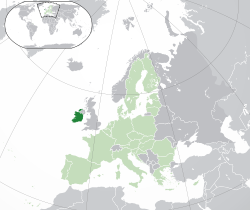
Republic of Ireland
Country in north-western Europe / From Wikipedia, the free encyclopedia
Dear Wikiwand AI, let's keep it short by simply answering these key questions:
Can you list the top facts and stats about Republic of Ireland?
Summarize this article for a 10 years old
Ireland (Irish: Éire [ˈeːɾʲə] ⓘ), also known as the Republic of Ireland (Poblacht na hÉireann),[a] is a country in north-western Europe consisting of 26 of the 32 counties of the island of Ireland. The capital and largest city is Dublin, on the eastern side of the island. Around 2.1 million of the country's population of 5.15 million people reside in the Greater Dublin Area.[10] The sovereign state shares its only land border with Northern Ireland, which is part of the United Kingdom. It is otherwise surrounded by the Atlantic Ocean, with the Celtic Sea to the south, St George's Channel to the south-east, and the Irish Sea to the east. It is a unitary, parliamentary republic.[11] The legislature, the Oireachtas, consists of a lower house, Dáil Éireann; an upper house, Seanad Éireann; and an elected President (Uachtarán) who serves as the largely ceremonial head of state, but with some important powers and duties. The head of government is the Taoiseach (Prime Minister, literally "Chief"), who is elected by the Dáil and appointed by the President; the Taoiseach in turn appoints other government ministers.
Ireland[a] | |
|---|---|
| Anthem: Amhrán na bhFiann "The Soldiers' Song" | |
 | |
| Capital and largest city | Dublin 53°20.65′N 6°16.05′W53°N 8°W |
| Official languages | |
| Ethnic groups (2022[2]) |
|
| Religion (2022[3]) |
|
| Demonym(s) | Irish |
| Government | Unitary parliamentary republic |
| Michael D. Higgins | |
| Leo Varadkar | |
• Tánaiste | Micheál Martin |
| Donal O'Donnell | |
| Legislature | Oireachtas |
| Seanad | |
| Dáil | |
| Independence from the United Kingdom | |
| 24 April 1916 | |
| 21 January 1919 | |
| 6 December 1921 | |
| 6 December 1922 | |
| 29 December 1937 | |
| 18 April 1949 | |
| Area | |
• Total | 70,273 km2 (27,133 sq mi) (118th) |
• Water (%) | 2.0% |
| Population | |
• 2022 estimate | |
• 2022 census | 5,149,139[5] |
• Density | 71.3/km2 (184.7/sq mi) (113th) |
| GDP (PPP) | 2023 estimate |
• Total | |
• Per capita | |
| GDP (nominal) | 2023 estimate |
• Total | |
• Per capita | |
| Gini (2022) | low |
| HDI (2021) | very high · 8th |
| Currency | Euro (€)[c] (EUR) |
| Time zone | UTC (GMT) |
| UTC+1 (IST) | |
| Date format | dd/mm/yyyy |
| Driving side | left |
| Calling code | +353 |
| ISO 3166 code | IE |
| Internet TLD | .ie[d] |
| |
The Irish Free State was created with Dominion status in 1922, following the Anglo-Irish Treaty. In 1937, a new constitution was adopted, in which the state was named "Ireland" and effectively became a republic, with an elected non-executive president. It was officially declared a republic in 1949, following the Republic of Ireland Act 1948. Ireland became a member of the United Nations in 1955. It joined the European Communities (EC), the predecessor of the European Union (EU), in 1973. The state had no formal relations with Northern Ireland for most of the 20th century, but the 1980s and 1990s saw the British and Irish governments working with Northern Irish parties to resolve the conflict that had become known as the Troubles. Since the signing of the Good Friday Agreement in 1998, the Irish government and Northern Irish government have co-operated on a number of policy areas under the North/South Ministerial Council created by the Agreement.
Ireland is a developed country with a quality of life that ranks amongst the highest in the world; after adjustments for inequality, the 2021 Human Development Index listing ranked it the sixth-highest in the world, behind Finland and ahead of Sweden.[12] It also performs well in areas such as healthcare, economic freedom, and freedom of the press.[13][14] It is a member of the EU and a founding member of the Council of Europe and the OECD. The Irish government has followed a policy of military neutrality through non-alignment since before World War II, and the country is consequently not a member of NATO,[15] although it is a member of Partnership for Peace and certain aspects of PESCO. Ireland's economy is advanced,[16] with one of Europe's major financial hubs being centred around Dublin. It ranks among the top 10 wealthiest countries in the world in terms of both GDP and GNI per capita.[17][18][19][20] After joining the EC, the country's government enacted a series of liberal economic policies that helped to boost economic growth between 1995 and 2007, a time now often referred to as the Celtic Tiger period. A recession and reversal in growth then followed during the Great Recession, which was exacerbated by the bursting of the Irish property bubble.[21]

